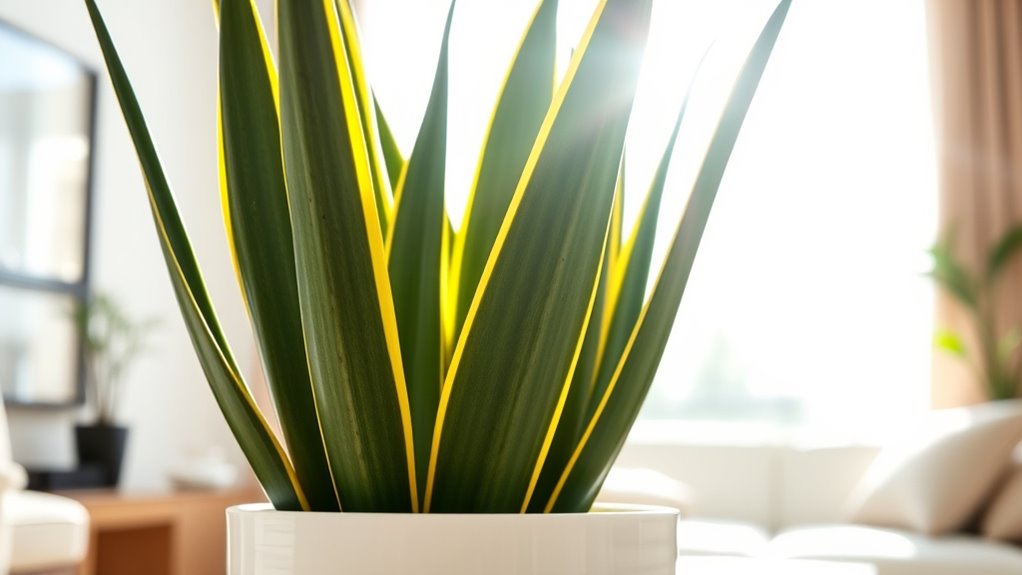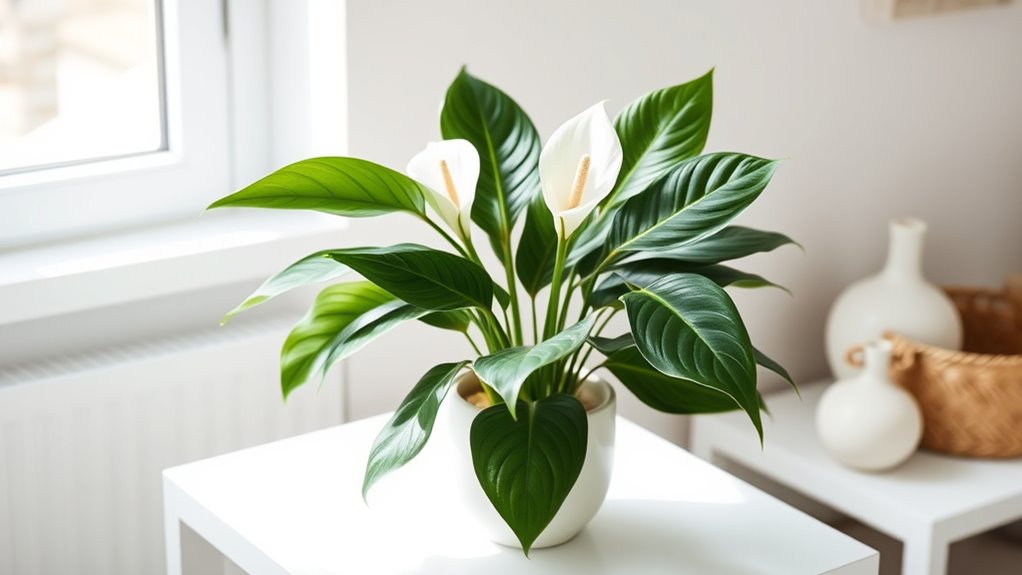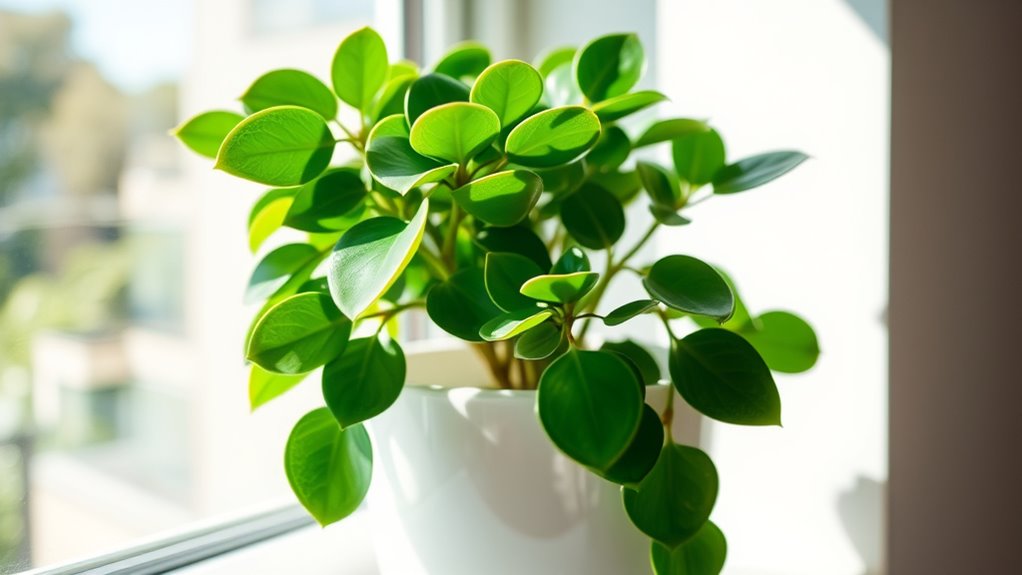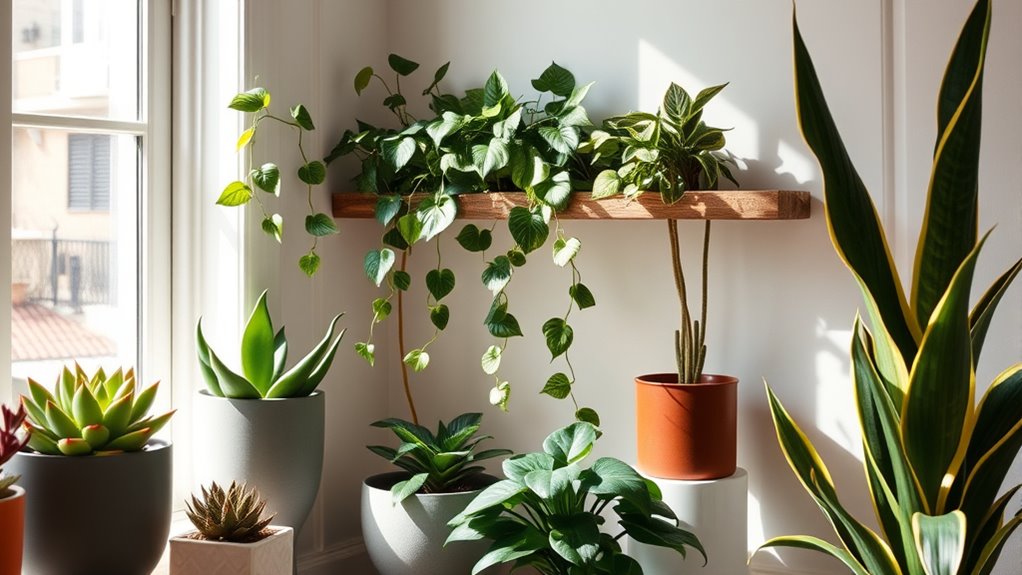Looking to brighten your space with easy-care plants? Consider options like snake plants, which thrive on infrequent watering and handle low light, or pothos, perfect for diverse lighting conditions. ZZ plants, peace lilies, and aloe vera also fit the bill, offering stylish appeal and practical benefits with minimal effort. These hardy plants resist pests and require only occasional watering. Want more tips on choosing the best low-maintenance houseplants? Keep exploring!
Key Takeaways
- Choose easy-care plants like Snake Plant, ZZ Plant, and Peace Lily that require minimal watering and resist pests.
- Opt for versatile plants such as Pothos, Spider Plant, and Aloe Vera adaptable to various light conditions.
- Incorporate practical and stylish plants like Aloe Vera and Jade Plant that offer decorative appeal and benefits.
- Follow proper watering and soil management, using well-draining soil and pots with drainage holes to prevent root rot.
- Regularly inspect for pests and wipe leaves to maintain healthy, pest-free indoor plants.
Snake Plant: The Hardy Indoor Classic

The Snake Plant, also known as Sansevieria, is a top choice for anyone seeking a low-maintenance indoor plant. You won’t need to worry much about watering frequency; it thrives on infrequent watering—about once every two to three weeks, allowing the soil to dry out completely between sessions. Overwatering can lead to root rot, so it’s better to err on the side of dryness. Pest management is straightforward, as snake plants are naturally resistant to most pests. However, keep an eye out for occasional mealybugs or spider mites, and wipe down leaves if you notice any pests. With minimal care needed, this hardy plant brightens your space without demanding constant attention. It’s perfect for busy or beginner plant enthusiasts. Additionally, since the plant requires minimal watering and care, it is well-suited for indoor environments with variable light, making it adaptable to different home settings.
Pothos: The Versatile Vining Wonder

Pothos is a low-maintenance plant that’s perfect for busy plant lovers. It requires minimal care and can thrive with just occasional watering. Plus, it adapts easily to different lighting conditions, making it a versatile choice for any space. Its hardy nature aligns with the concept of vetted plants for safety and effectiveness, ensuring it remains a reliable addition to your home.
Easy Care Requirements
Because they thrive on minimal attention, pothos are incredibly easy to care for. You don’t need to worry about frequent watering; watering once every 1-2 weeks is usually enough, allowing the soil to dry out between sessions. When it comes to soil preferences, pothos prefer well-draining soil that retains some moisture but doesn’t stay waterlogged. A standard houseplant mix with perlite or sand works well. They’re forgiving if you forget to water occasionally, making them perfect for busy schedules. Additionally, pothos tolerate a range of soil conditions, so you don’t need to be overly precise. Keep in mind that overwatering can lead to root rot, so less is often more. Overall, their low-maintenance nature makes them an easy choice for brightening any space.
Adaptable Lighting Needs
Although they thrive in a variety of lighting conditions, pothos are especially versatile when it comes to placement. They adapt well to both natural sunlight and artificial lighting, making them ideal for any space. If you have limited access to direct sunlight, pothos can still flourish under fluorescent or LED grow lights. Conversely, in bright, indirect sunlight, they develop vibrant leaves and faster growth. You don’t need to worry about perfect lighting; just make certain they aren’t exposed to harsh, direct sun that can scorch their leaves. Whether on a shaded windowsill, a desk with a lamp, or a well-lit corner, pothos will adjust easily. Their light adaptability allows them to thrive in diverse environments, ensuring they brighten up your space with minimal effort. This adaptability makes them a perfect low-maintenance choice for brightening up any room.
ZZ Plant: The Tolerant and Trendy Choice

The ZZ plant is known for its durability and minimal care needs, making it perfect for busy or forgetful plant owners. Its sleek, upright leaves add a modern touch to any space, boosting indoor style effortlessly. With its tolerance for low light and infrequent watering, it’s a trendy and practical choice for your home. Additionally, its adaptability makes it suitable for various indoor environments, including low-maintenance houseplants.
Durability and Care Needs
ZZ plants are known for their remarkable durability, making them ideal for busy or forgetful plant owners. They thrive on infrequent watering and can tolerate neglect, needing only watering every 2-3 weeks. Their pest resistance is impressive; they rarely attract common houseplant pests like spider mites or mealybugs. You’ll find that they handle low light conditions well, adding greenery without extra effort. To keep your ZZ plant happy, avoid overwatering, which can lead to root rot. They’re forgiving if you forget to water for a bit longer than usual. Additionally, their sturdy leaves and thick rhizomes make them resilient against physical damage. Because of their low-maintenance nature, ZZ plants are often recommended for indoor environments where light and care might be less than optimal. Overall, they’re a low-maintenance, durable choice that fits seamlessly into any space.
Stylish Indoor Appeal
If you’re looking to add a touch of elegance to your home, the ZZ plant delivers with its sleek, modern appearance. Its glossy, dark green leaves complement various interior styles, enhancing your garden aesthetics. This plant’s upright, architectural form creates a sophisticated focal point without demanding much outdoor maintenance. Its tolerant nature means you can enjoy its stylish appeal even in low-light areas. Additionally, its low-maintenance requirements make it an ideal choice for busy households.
Peace Lily: The Elegant Air Purifier

Have you ever noticed how a simple plant can transform your indoor air quality while adding a touch of elegance? The Peace Lily is perfect for this, effortlessly purifying your air and enhancing your space’s aesthetic. Its sleek white flowers and lush green leaves make it a versatile addition to any room. You can incorporate it into a flower arrangement for a sophisticated look or place it on a side table for easy care. Peace Lilies also help with pest control by naturally deterring certain insects. Keep the soil moist and avoid overexposure to direct sunlight, and your plant stays healthy. Its low-maintenance nature means you enjoy cleaner air and stylish decor without much effort. Additionally, Peace Lilies are known for their air-purifying qualities, making them a practical choice for improving indoor environments. Truly, it’s an elegant, practical choice for any home.
Spider Plant: The Resilient and Air-Cleaning Favorite

The Spider Plant is renowned for its resilience and exceptional ability to improve indoor air quality. It’s easy to care for, making it perfect for busy spaces. To keep it healthy, you should follow a regular watering schedule—about once a week, allowing soil to dry slightly between waterings. Be vigilant about pest prevention; common issues include spider mites and aphids. Regularly inspect your plant and wipe leaves with a damp cloth to deter pests. Here’s a quick guide:
| Care Tip | Details |
|---|---|
| Watering schedule | Once a week; let soil dry between waterings |
| Pest prevention | Inspect leaves regularly; wipe with damp cloth |
| Light requirements | Bright, indirect sunlight |
With minimal effort, your spider plant will thrive and purify your air, promoting a healthier indoor environment through evidence-based practices.
Aloe Vera: The Practical and Decorative Succulent

Aloe Vera stands out as both a practical remedy and a stylish addition to your home decor. Its thick, fleshy leaves add a natural, aesthetic benefit to any space, while offering health benefits like soothing skin. To keep your aloe healthy, follow simple care tips: place it in bright, indirect sunlight, water sparingly when the top inch of soil is dry, and ensure proper drainage. Its low-maintenance requirements make it ideal for busy or novice plant owners. The plant’s unique look complements modern decor and adds a fresh, vibrant touch. With minimal effort, you enjoy its resilience and beauty, making Aloe Vera a perfect low-maintenance houseplant that brightens your space and provides practical benefits. Additionally, its ability to adapt to various environments makes it a versatile choice for different living spaces.
Jade Plant: The Easy-Care Lucky Charm

A jade plant is a popular low-maintenance houseplant believed to bring good luck and positive energy. To keep it thriving, pay attention to your watering schedule—water only when the top inch of soil feels dry. Overwatering can cause root rot, so less is more. The soil preferences for a jade plant include well-draining cactus or succulent mix, which prevents excess moisture. Here’s a quick guide:
| Watering Schedule | Soil Preferences |
|---|---|
| Every 2-3 weeks | Well-draining cactus or succulent mix |
| Allow soil to dry | Avoid heavy, water-retentive soils |
| Adjust for season | Use pots with drainage holes |
| Reduce watering in winter | Use sandy or gritty soil |
| Watch for signs of overwatering | Ensure proper drainage |
Following these tips helps your jade plant stay healthy and vibrant. Regularly monitoring soil moisture levels ensures optimal watering and plant health.
Frequently Asked Questions
How Often Should I Water Low-Maintenance Houseplants?
You should water your low-maintenance houseplants roughly once every 1-2 weeks, but always check the moisture levels first. Stick your finger about an inch into the soil; if it feels dry, it’s time to water. Adjust your watering schedule based on the plant’s environment—bright, warm spots may require more frequent watering. Avoid overwatering, as it can lead to root rot and harm your plants.
What Is the Ideal Lighting Condition for These Plants?
Think of your houseplants as solar panels—they thrive in the right amount of light. For low-maintenance plants, aim for bright, indirect natural light or use artificial lighting that mimics sunlight. Position them near windows with filtered light or under grow lights if natural light is limited. Consistency is key, so find a spot with steady, gentle illumination to keep your plants happy and healthy.
Are These Plants Safe for Pets?
Many low-maintenance houseplants are pet safe, but it’s vital to distinguish between toxic and non-toxic varieties. You should always check if a plant is labeled as pet safe before bringing it home, especially if you have curious pets. Non-toxic plants like spider plants, areca palms, and Boston ferns are great options, while toxic ones like pothos or philodendrons should be avoided to keep your pets safe.
How Can I Prevent Pests on These Houseplants?
Think of your houseplants as a fortress, and pests as unwelcome invaders. To keep them at bay, adopt pest prevention strategies like inspecting leaves regularly and removing debris. Use organic pest control methods such as neem oil or insecticidal soap to deter pests naturally. Maintaining proper airflow and not overwatering also helps prevent infestations. With these simple steps, your plants stay healthy and pest-free, shining bright in your space.
Do These Plants Require Fertilization, and How Often?
You don’t need to fertilize these plants often; a simple fertilizer schedule of once a month during the growing season usually suffices. They have modest nutrient requirements, so over-fertilizing can harm them. Use a balanced, water-soluble fertilizer diluted to half strength. During winter, skip fertilization altogether. This approach keeps your plants healthy without much effort, ensuring they stay vibrant and thriving with minimal fuss.
Conclusion
With these low-maintenance houseplants, you’re all set to brighten your space effortlessly. It’s funny how a simple plant can turn a dull corner into a lively oasis — just like that snake plant you found when you weren’t even looking. Whether you prefer the sleek aloe vera or the lucky jade, these easy-care choices prove that adding greenery doesn’t have to be complicated. Who knew that a little greenery could make such a big difference?









